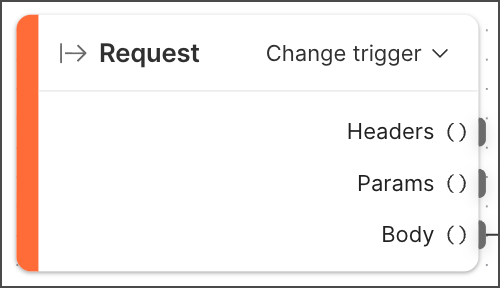The Request block

The Request block is a special block that’s present by default in Flows actions. The Request block takes request data sent to a deployed action’s URL and routes the data through its Headers, Params, and Body output ports. The Request block can’t be added or deleted.
You can change a Request block to a Schedule block to run the action at regular intervals or at specific times. To learn how, see Schedule an action to run automatically.
Prior to an action being deployed, the Request block takes the values for headers, parameters, and the request body that you store in scenarios. By running different scenarios, you can test how your action will behave once it’s deployed. Testing with scenarios is necessary because the action won’t have a URL until you deploy it.
The Request block can ingest input data of up to 5 megabytes if you’ve purchased the Flows add-on, or 1 megabyte if you’re using Flows for free.
Outputs
- Headers - Sends the request headers to the deployed action’s URL.
- Params - Sends the request’s query parameters to the deployed action’s URL.
- Body - Sends the request body to the deployed action’s URL. Actions support JSON,
form-data, andx-www-form-urlencodedformats.
Setup
The Request block itself requires no setup, but it does require you to create at least one scenario with data that the Request block can take as input. This is a prerequisite for testing your action locally. By testing, you verify that the blocks you add make your action perform the desired work.
The procedure for creating a scenario depends on the type and structure of the data you plan to send in the request body.
This procedure assumes you already know the JSON structure of the action you’re creating will require, or that you have a correct example request body available to copy and paste. If that’s not the case, see Send URL-encoded or form data to actions in Postman Flows.
-
Create a scenario and type or paste a correctly structured example request body into the Body field. For an empty request body, use the empty JSON object
{}. -
(Optional) Add content for the Headers and Query Params fields as needed.
-
Save and run the scenario.
-
Click the Body output of the Request block to open the block footer, and verify that the block emitted the correct request body, headers, and parameters.
Related blocks
The Request block is one of the three blocks that every action has upon creation. The others are the Template and the Response block.
Last modified: 2025/10/08